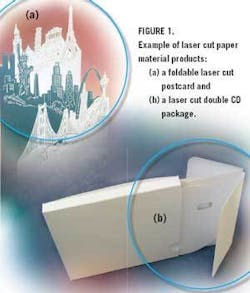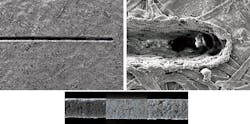Cutting paper
Heidi Malmberg and Veli Kujanpää
The combination of laser with paper technologies has been studied for more than 30 years. One of the first successful commercial industrial applications was perforating cigarette filter paper. Even so the implementation of laser technology in the paper/board manufacturing industry remained limited because of the high investment costs and a lack of basic knowledge and research results. This situation changed in the late 1990s: laser equipment selling prices decreased, improved lasers were developed, and the laser technology, in general, became more reliable. The result of this, as shown in Figure 1, is that the paper industry has begun to pay attention to laser cutting technology.
Why lasers?
In this industry there are several needs for cutting such as edge trimming of web in paper machine, cross-machine direction cutting of web, slitting of web, sheeting of web, and cutting of package blanks.
High-speed cutting of paper materials is needed in the paper/board making and converting industry, where the cutting of fiber material is done, conventionally, by mechanical cutting. In the 1980s, high-pressure water jet cutting became a competitive cutting method especially in edge trimming. In the late 1990s the laser beam method became a new challenge for these two older mechanisms.1
There are several problems when paper/board is cut mechanically, which make the cutting quality bad or can even destroy it. One is dust in mechanical cutting, which consists of pieces of fiber and pigment particles ripped out by the cutting blades, causing production problems in printing houses, for example. Coarse cut edges, with fiber endings sticking out is a problem because of their liquid absorption properties.2.3 This is especially true in food packaging board shown in Figure 2, a scanning electron microscopy (SEM) image of laser and mechanically cut edge of paper material.In water jet cutting, edge quality depends on water pressure, size of nozzle hole, nozzle distance, and speed of the web. Water jet cutting of paper materials is not totally problem-free, for example the edge of wood fiber materials swells and the paper material web is severely shrivelled.2,4
Technically, laser cutting of paper/board is possible and the cut kerf quality is very good. Also the amount of dust released during laser cutting is much lower than with mechanical or water jet cutting. The most important advantage of laser technology is its flexibility where batch sizes of one piece to 10,000 pieces can be accomplished.5,6
Laser cut edges are clean, sealed, and contain no fiber endings sticking out. Laser cutting does not affect the properties of the fiber material, and further processing of material is problem-free. Also recycling of material with laser cut edges is problem-free.5 SEM images in Figure 3 show laser cut kerf and cut edge of different paper materials.There are significant differences when comparing laser cutting to conventional mechanical cutting methods. Laser cutting is a flexible method; when the pattern geometry is changed there is no need to change the tool. Laser cutting is a contact-free method so there is no tool wear. Laser cutting is almost dust-free. With laser cutting, material loss can be reduced because cut blanks can be positioned so that material loss is slight. Complex geometries can be cut at fast speeds; laser cutting speeds are the same as or higher than mechanical cutting.
Industrial applications
There are several application possibilities for laser cutting in papermaking processes. Laser cutting of uncoated and coated paper materials can be done successfully, and printed paper and board can be cut with a laser beam.5,7
Lasers can be used for slitting paper material web in a paper/board machine2 and they can replace water jet cutters in edge trimming processes. Researchers at the Laboratory of Laser Processing at Lappeenranta University of Technology (Finland), working on a national project, found that a commercial magazine paper can be cut at a speed of 4400 m/min, which fulfils the papermaking process requirements.
The laser beam is used for manufacturing of opening grooves to packages by partial cutting of paper materials where the beam energy evaporates part of the material. In this application, laser cutting provides several advantages: the groove is more uniform and the groove depth can be precisely defined. Plastic and aluminum layers remain untouched; important when hygienic properties of food packages are considered.8
Laser cutting can be combined with digital printers. Conventionally, paper materials have been printed with rotogravure or offset method, batch sizes are large (several ten thousand pieces), and each change in print image needs modification of the print tool. The advantage of digital printing is that small batch sizes (dozens or hundreds of pieces) can be printed, and changing a print image is only a programming function. As an on-line cutter, the laser could provide flexibility in digital printing where a cutting pattern change would only be a question of programming with no new cutting tool needed.9
Paper materials can be laser perforated with high speed and high accuracy. When mechanical perforation is used, there is a problem of material strength loss due to broken fibers and the uneven size of perforated holes due to wearing of the perforation tool.10
Laser cutting of paper materials is recommended when; cutting is done manually, wherever production size is small or constantly below 1000 pieces, when digital printing is used, and when high accuracy with complex geometries is needed. Also, it is recommended when specimen or sample batches are made and the material is expensive and maximum acquisition is needed. Also, when flexible production and fast delivery are needed and when tailor-made products are needed laser cutting is a good choice.
Economic aspects
The calculations done during the national project at Lappeenranta University of Technology show that the economic difference between conventional technologies and laser technology is not large. This comparison was done for an edge trimming system where annual costs of the laser systems are higher than the water jet edge trimming system. The difference between the laser and the water jet cutting system annual cost depends on the design of the laser system. Annual costs on the most advantageous laser system are only five percent higher than water jet cutting systems while the difference is nearly 45 percent on the most expensive alternative, explained by different backup systems and higher laser power.
Laser systems operating costs are €45,000 - 60,000/year, which is four times more than water jet cutting systems. That is explained by the 10 percent electrical conversion efficiency of the laser and the laser gas expenses. Despite this, laser cutting has several advantages over water jet cutting: in laser cutting equipment there is no mechanical part to wear, the laser is always “sharp,” and cut edge is dust free and not swollen. Additionally, the laser enables cutting of complex geometries. Water jet cutting is mainly used for direct linear cutting.
In edge trimming, significant laser benefits are attained in reliability and maintenance-free operation. Reliability is most important in edge trimming because losses are huge on paper machine if there are unexpected production breaks. Five unnecessary steps could be avoided if the laser is utilized on edge trimming rather than water jet cutting.
The second researched laser application was zigzag cutting of board where benefits resulted in material efficiency in a drink cup application. It is possible to get 5-9 percent material cost savings utilizing laser cutting in the winding process.
With laser systems capital costs accounting for about 50 percent, with purchase price tied to laser output power, productivity of the laser system has to be maximized because income is the only variable in the economic aspect. Costs of the laser system are mostly constant and most of them cannot be influenced after the purchase decision.
Conclusions
Combining laser technology and paper technology has been studied for more than 30 years and yet the use of lasers in the paper/board manufacturing industry remains low.
In paper/board making processes there is a need for changes in high-speed cutting because of the problems associated with the dust resulting from mechanical cutting. In water jet cutting of paper, the material swells and the web can become shriveled.
Technically laser cutting of paper/board produces clean, dust-free edges with no fiber endings sticking out that can act as moisture wicks. Lasers can be used for slitting of webs in paper machines and they can replace water jet cutters in edge trimming. Lasers can also be combined with digital printers.
Calculations show the economic difference between the traditional technologies and laser technology is not great. Two cases examined were edge trimming of paper material web with laser/water jet and zigzag laser cutting of a web. Calculations for the edge trimming system show the annual costs for the laser systems are higher than the water jet edge trimming system due to design of the laser system. However, there were significant benefits gained in material efficiency in drink cup production when laser zigzag cutting made possible the flexible cutting of geometries and optimization of the winding activity.
Laser technology is attractive even though annual costs are higher than current technologies. Significant benefits are attained by reliability and maintenance-free operation. It is estimated that, if the laser is utilized on edge trimming, five unnecessary steps could be avoided compared to water jet cutting.
References
1. Anon., “Cutting it fine,” Paper, vol. 217, 1992 no. 5, p. 38.
2. Ramsay, I., Richardson, B., “Workington tries laser slitting on coated paperboard,” Paper Technology, vol. 33, 1992, no. 9, pp. 17-22 .
3. Anon., “Laser - soveltuuko puuntyöstöön?,” Paperi ja Puu, vol. 68, 1986, no. 10, pp. 694-696.
4. Schable, R., “Changing slitting methods,” Paper, film & foil converter, vol. 67, 1993, 9, pp. 82-83.
5. Ainsworth, H., “Laser cutting,” Paper Technology and Industry, 1978, no. 9, pp. 220-225.
6. Rickli, M., “Alternative Schneidtechniken für Papier,” Diploma Papier, Lausanne, 1982.
7. Federle, H., Keller, S., “Papierschneiden mit Laser (Teil 1),” Papier+Kunststoff+Verarbeiter, vol. 27, 1992, no. 7, pp. 32-39.
8. Henning, D., “Scoring big with lasers: lasers and packaging technology,” Flexible Packaging, 2001, no. 1, pp. 33-34.
9. Boyle, E., “Lasers are on the cutting edge, digitally speaking,” Paper, film & foil converter, 1999, no. 4, pp. 14-15.
10. Federle, H., Keller, S., “Papierschneiden mit Laser (Teil 2),” Papier+Kunststoff+Verarbeiter, vol. 27, 1992, no. 9,S.54-58.
Heidi Malmberg and Veli Kujanpää ([email protected]) are with the Laser Processing Laboratory, Lappeenranta University of Technology (Lappeenranta, Finland) where Veli also is associated with the Technical Research Center (VTT).


